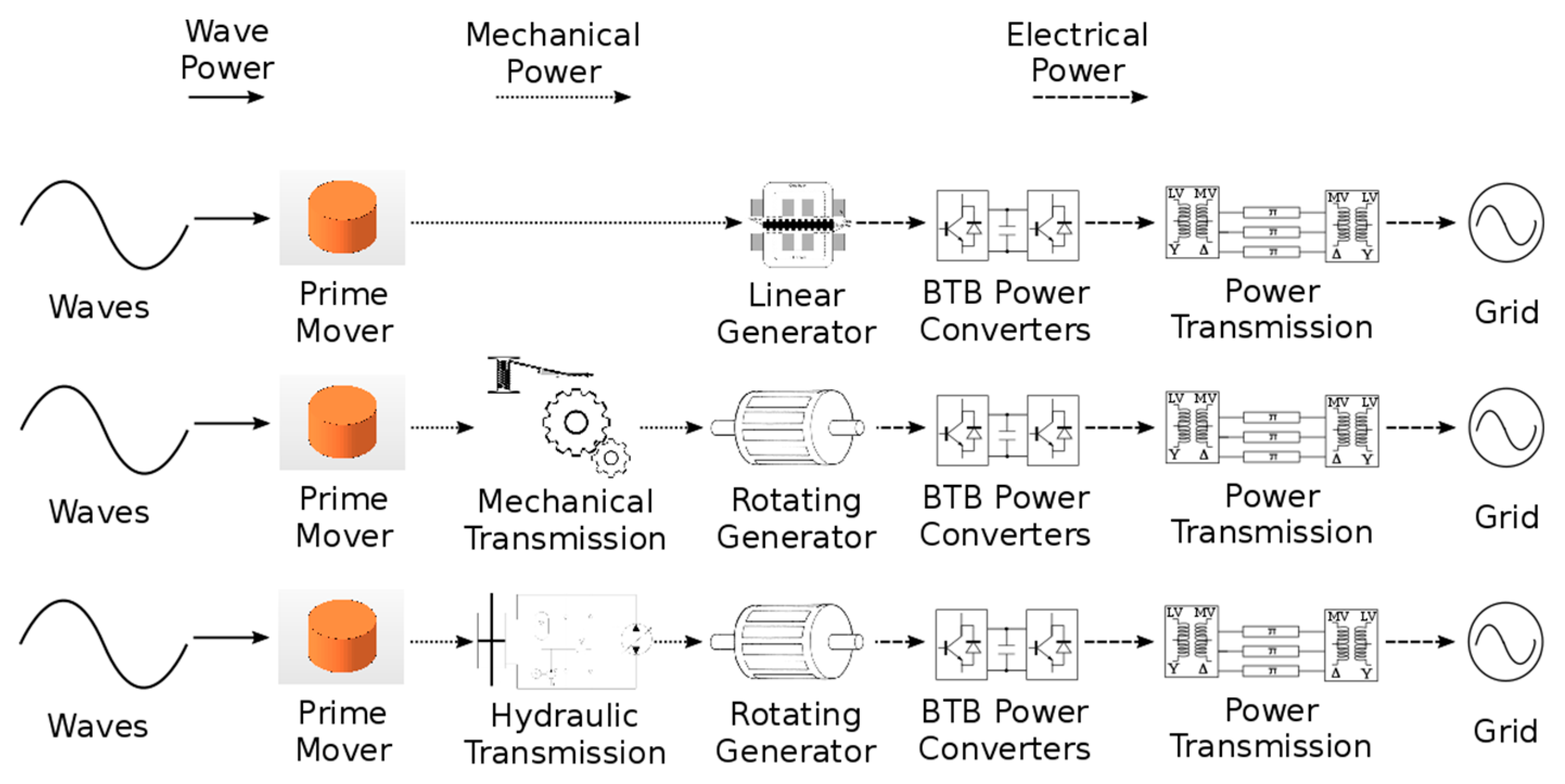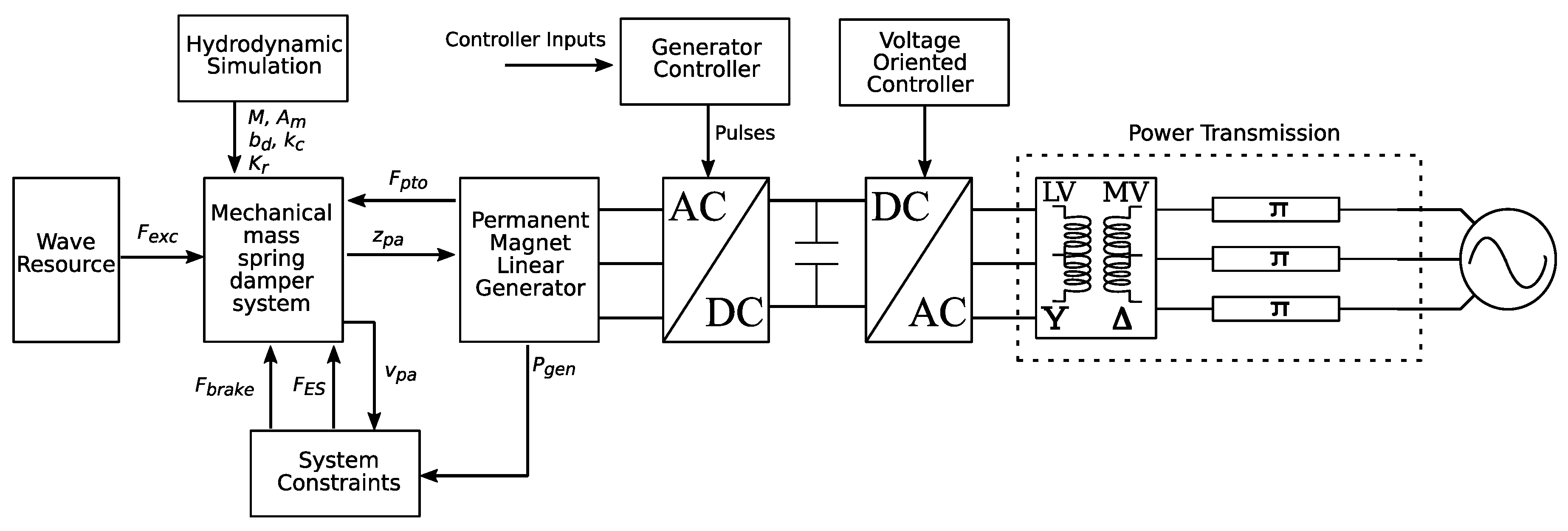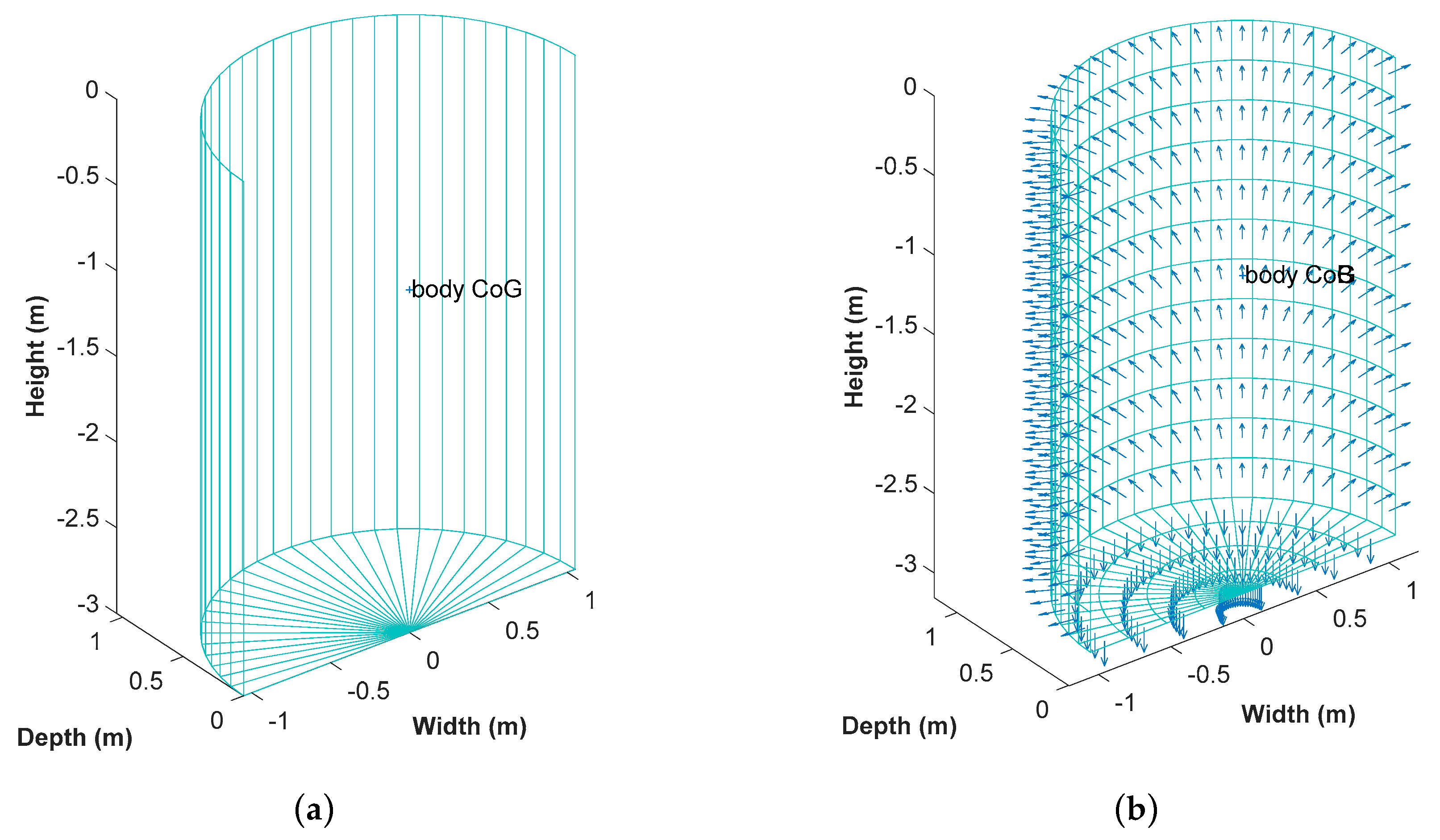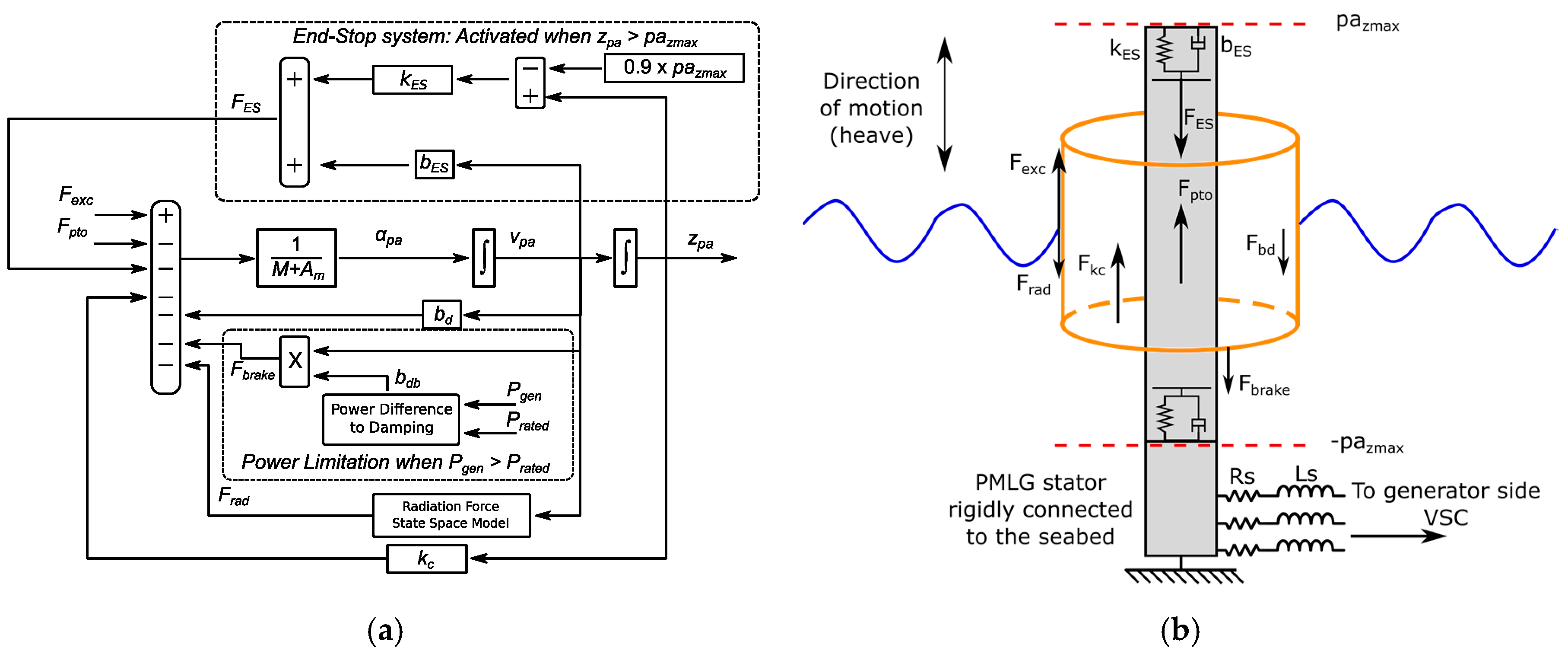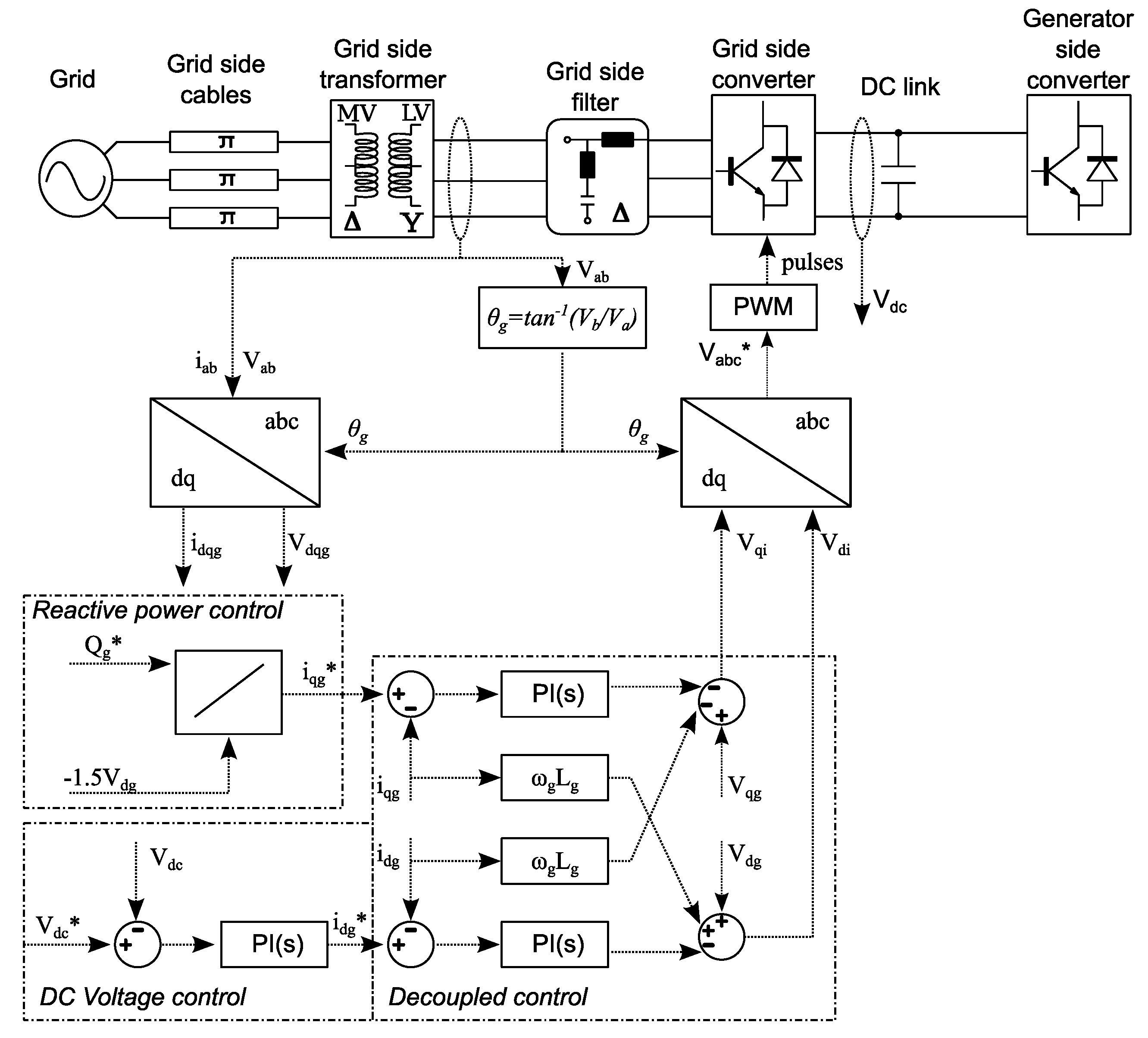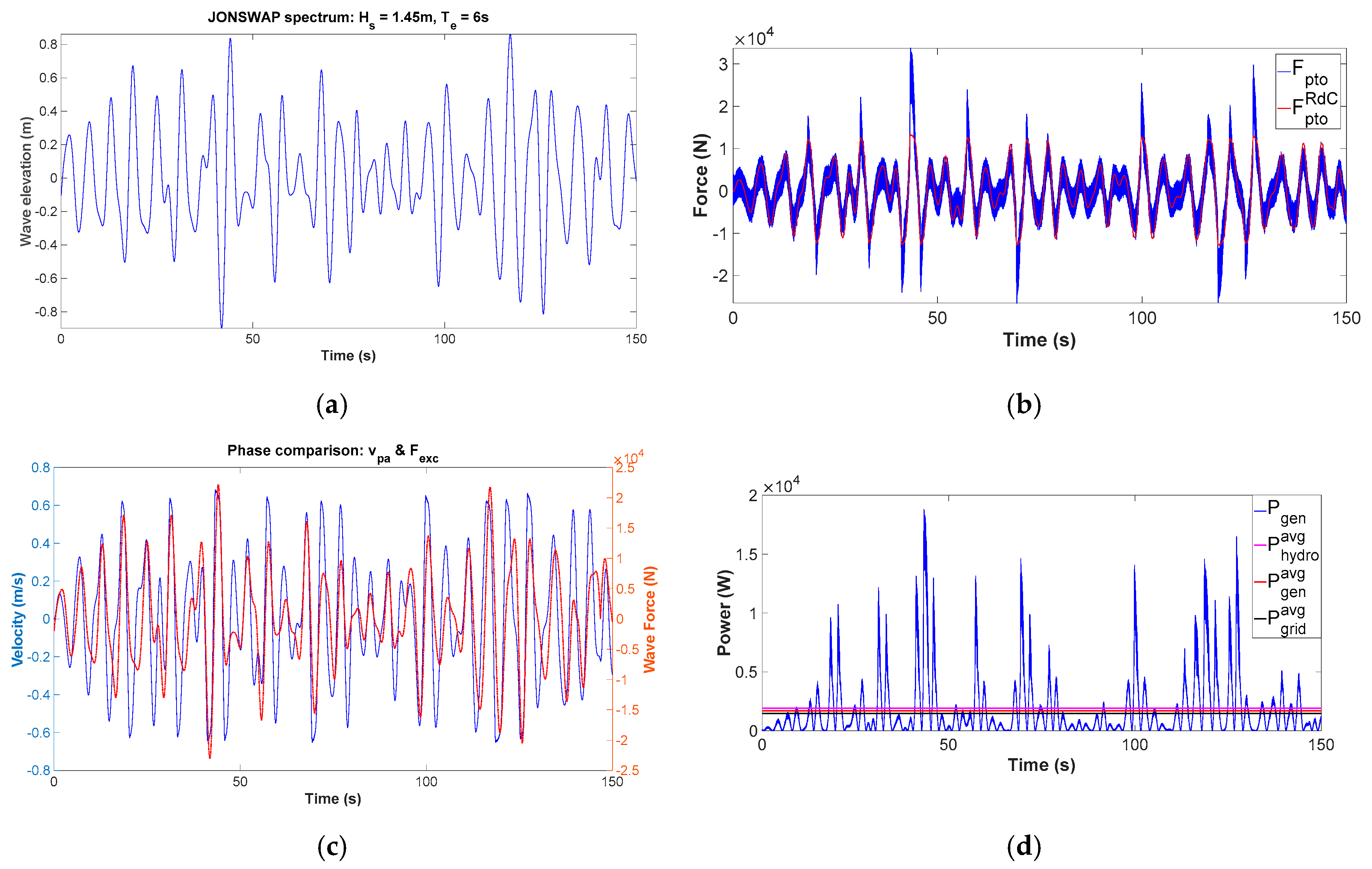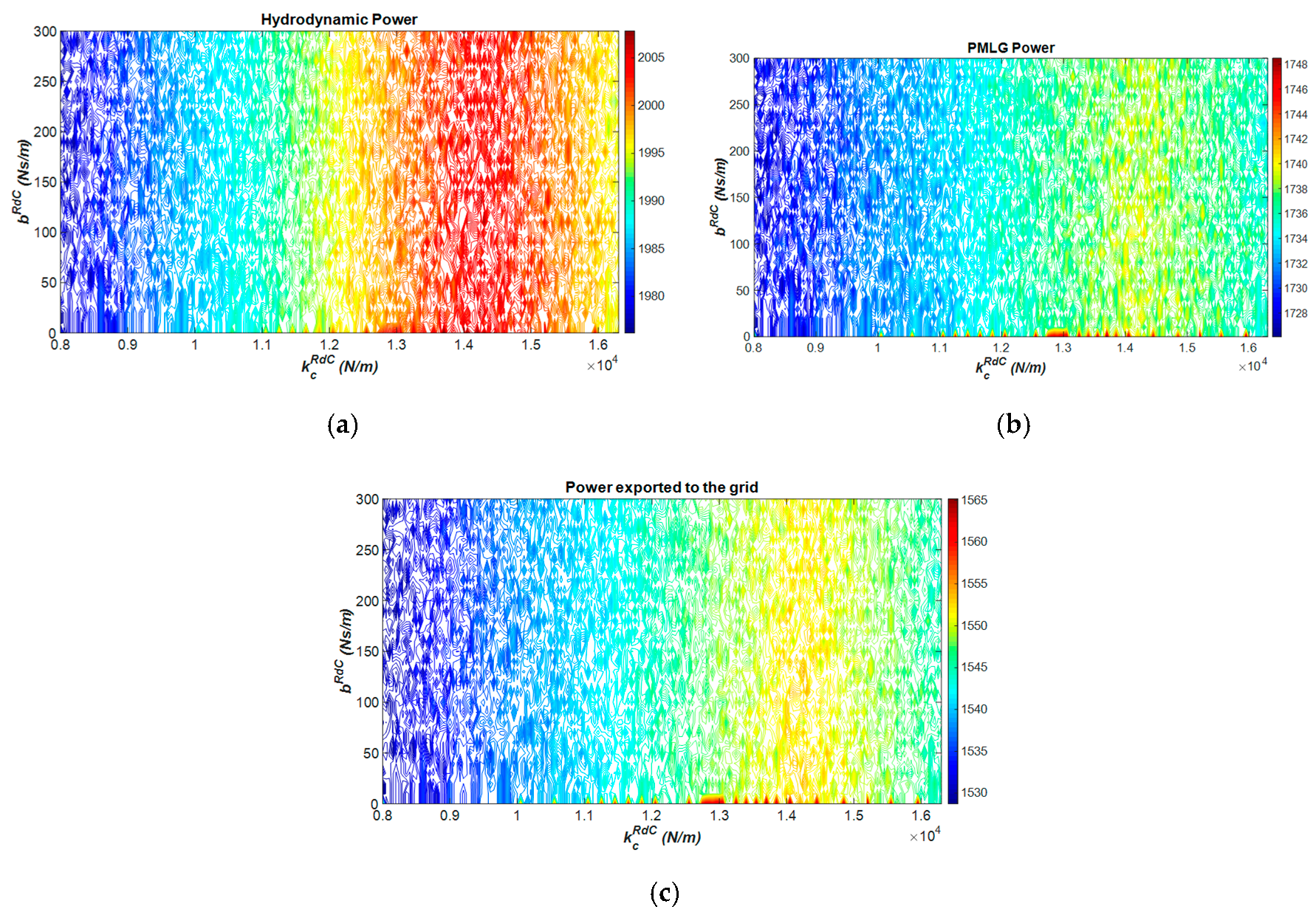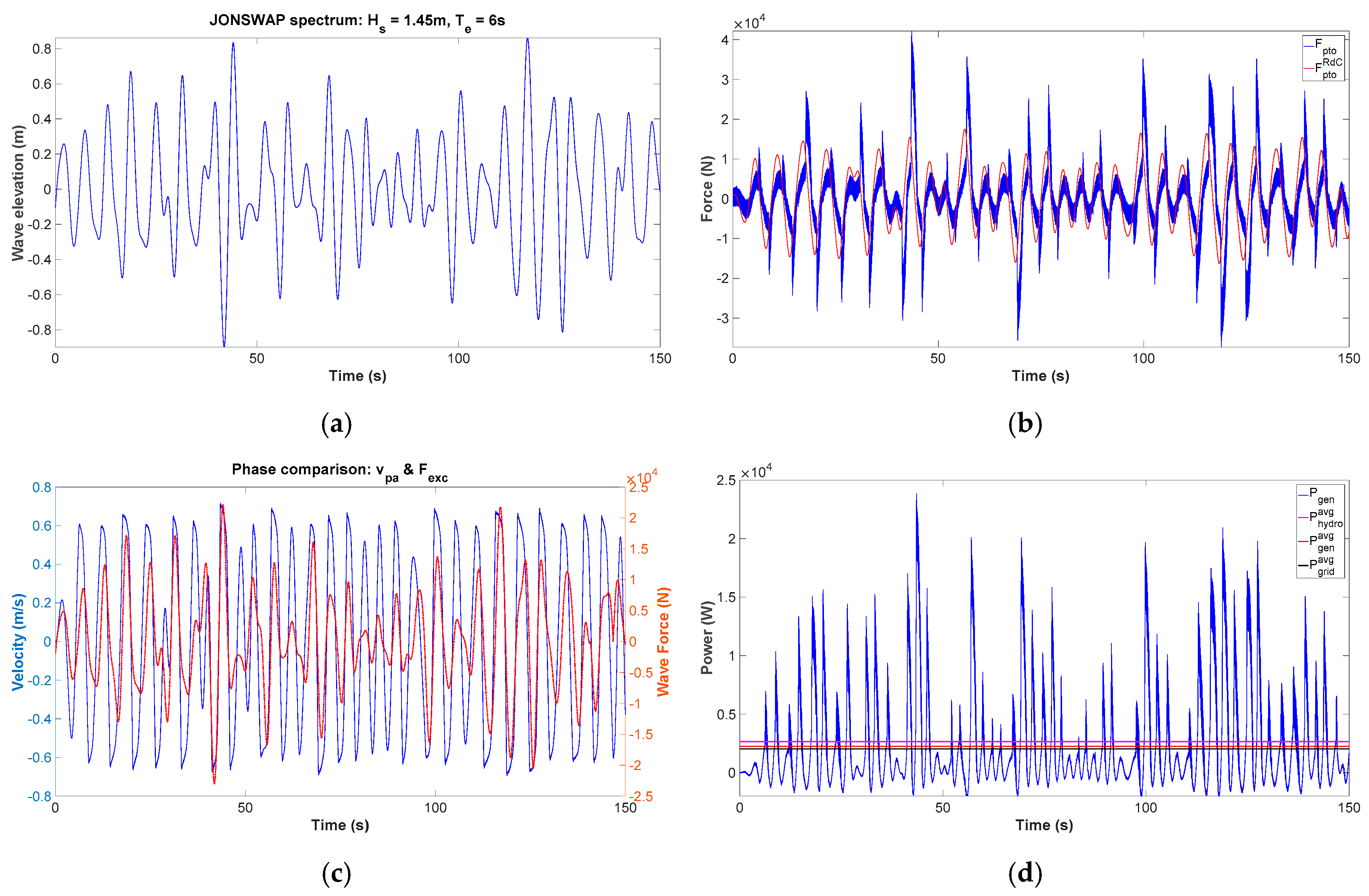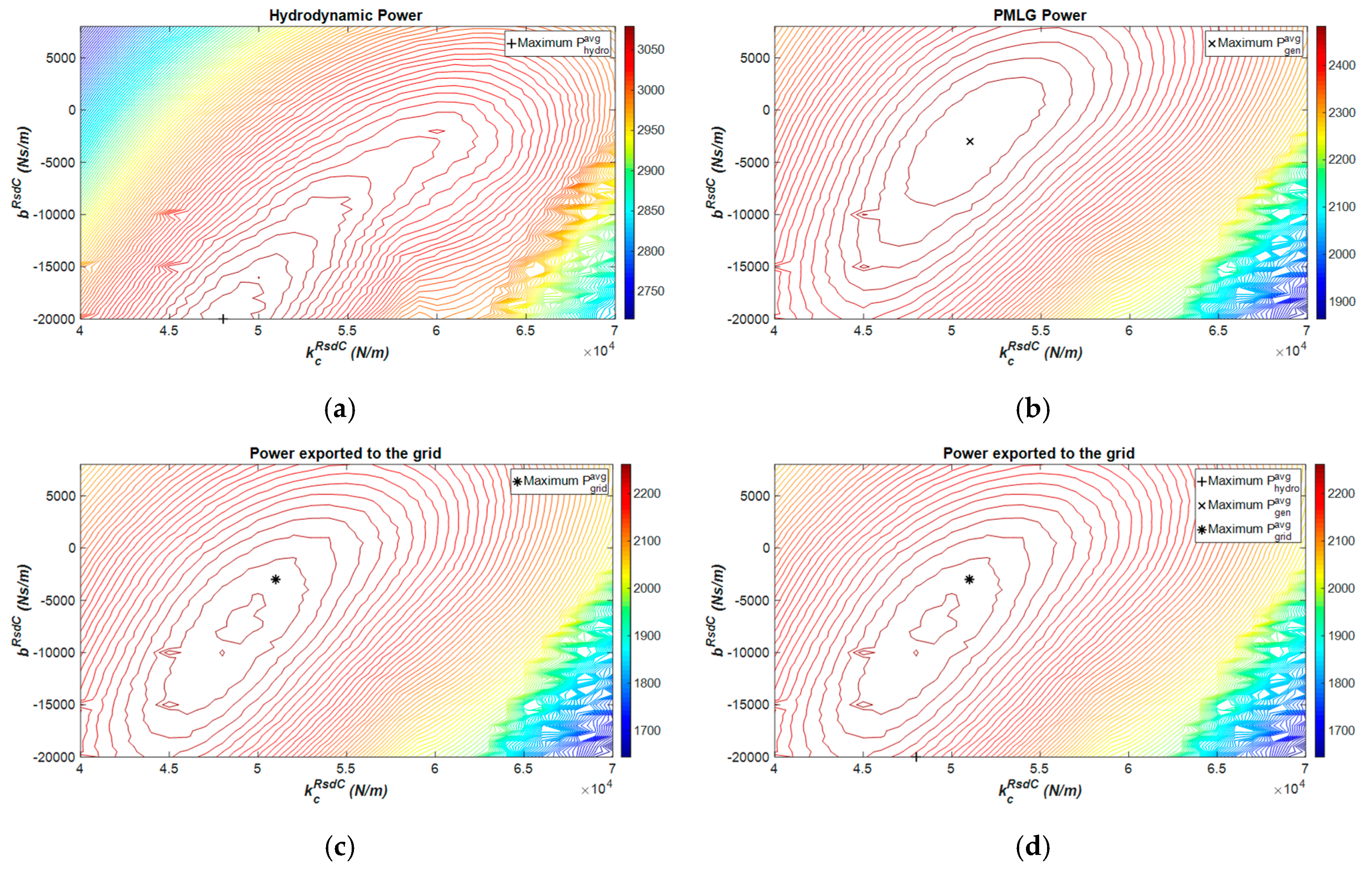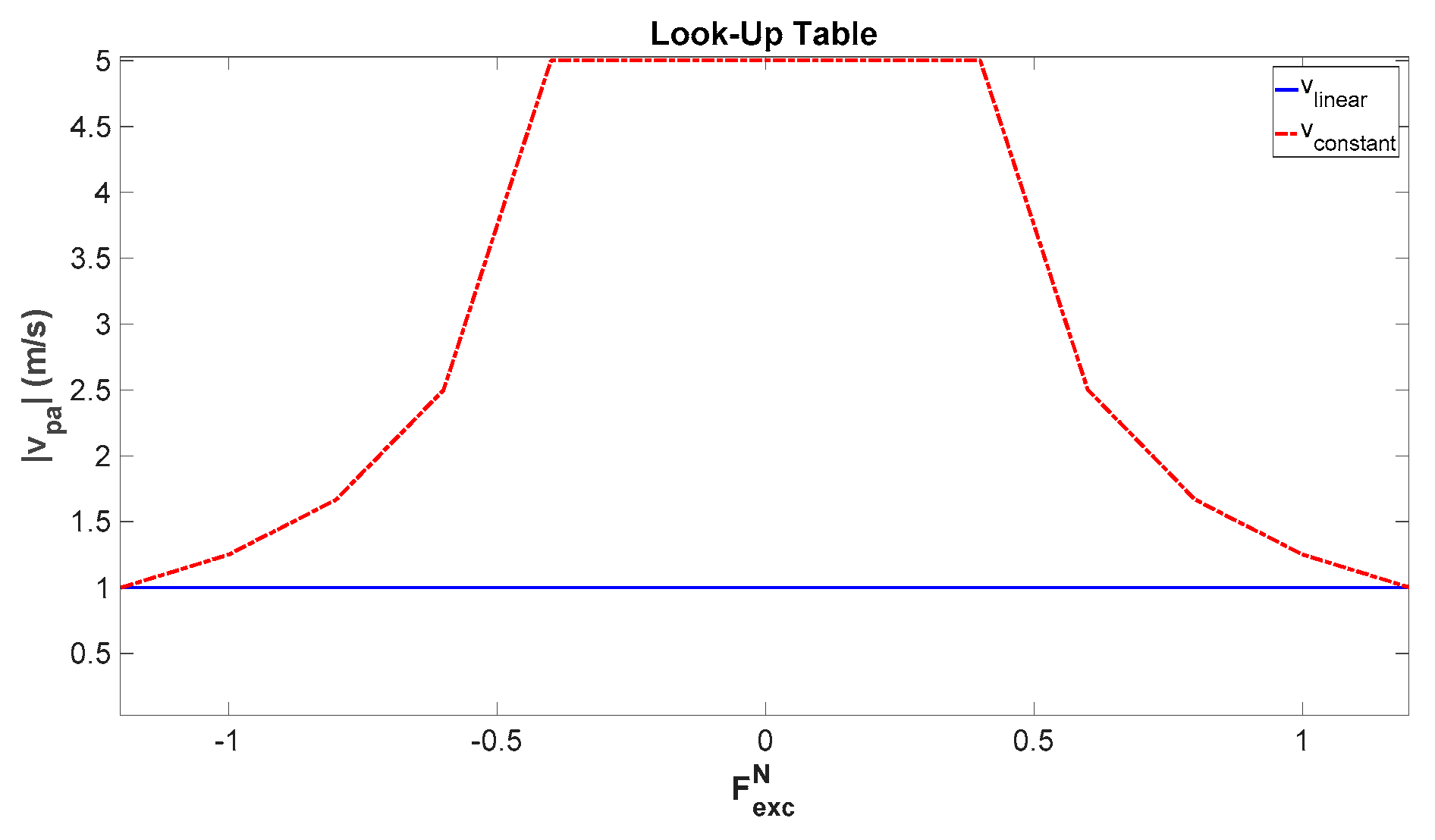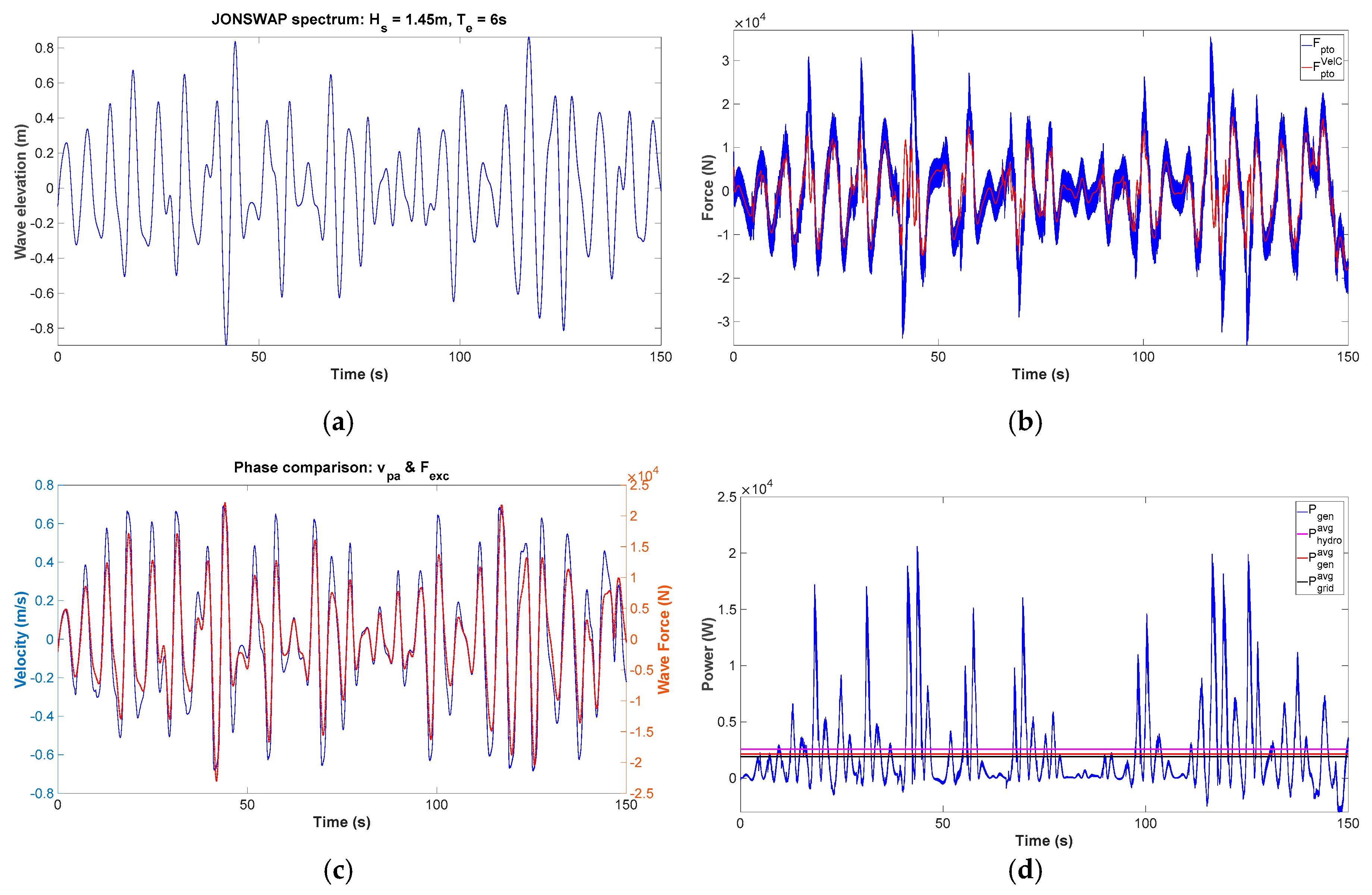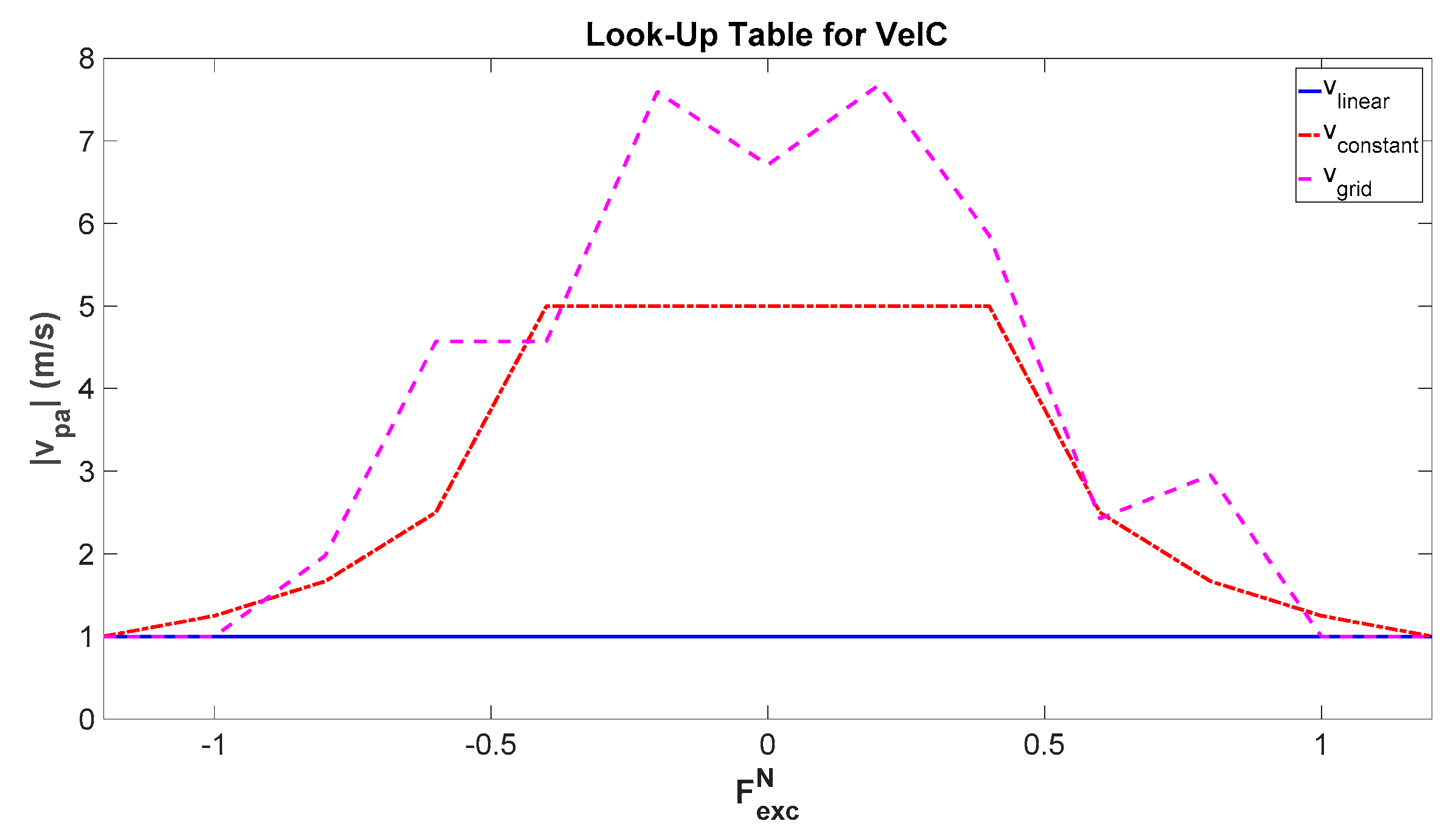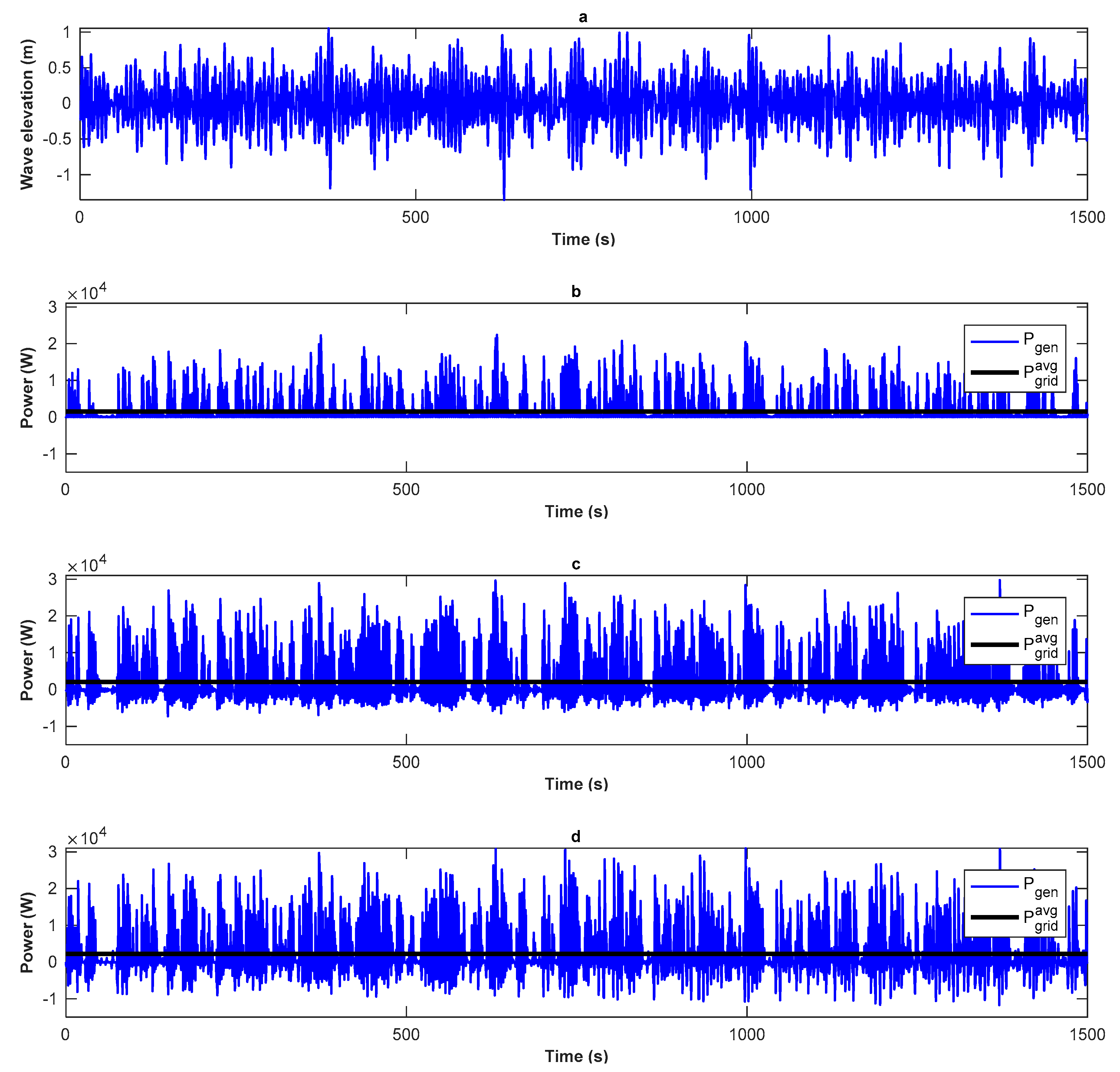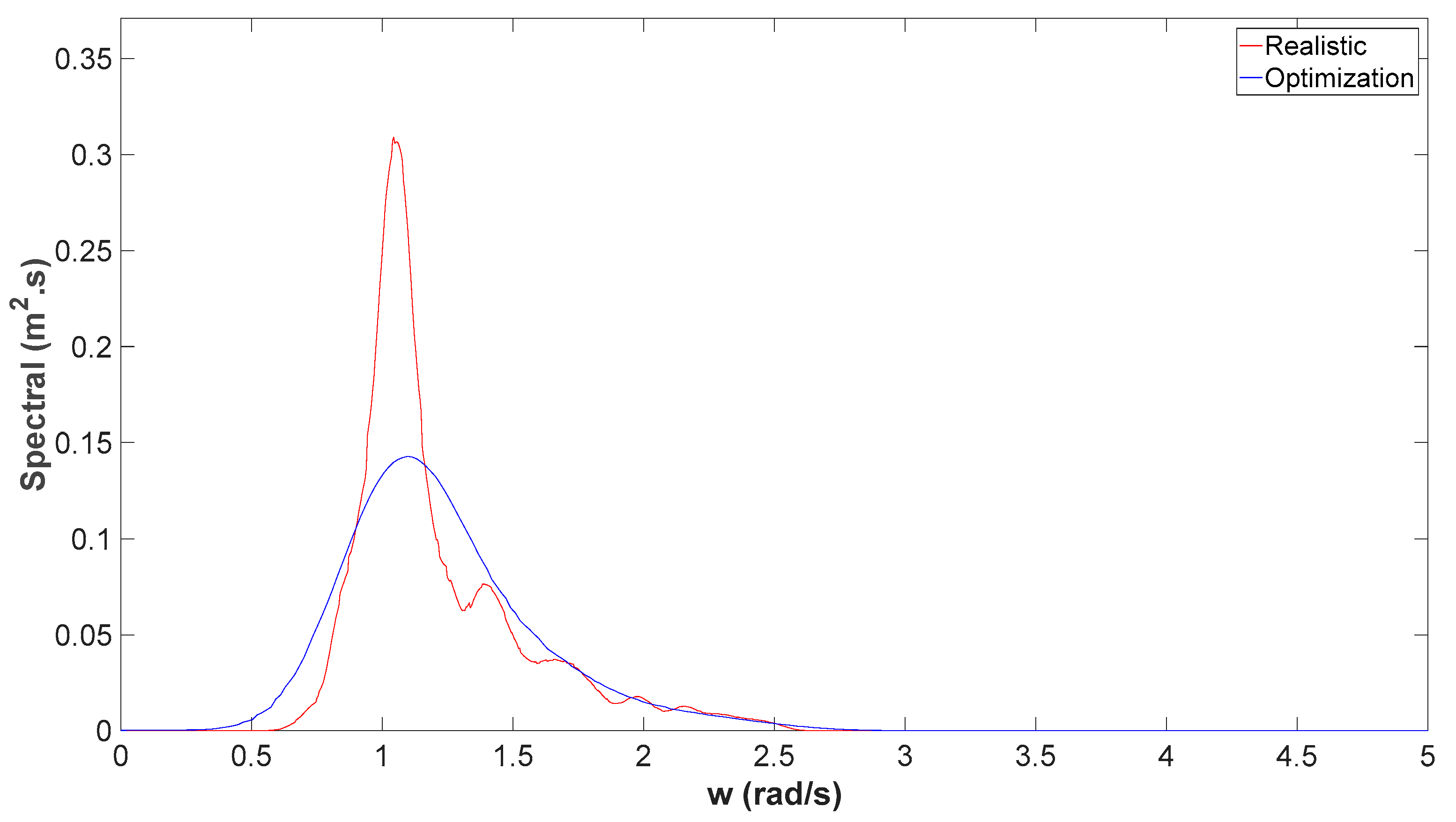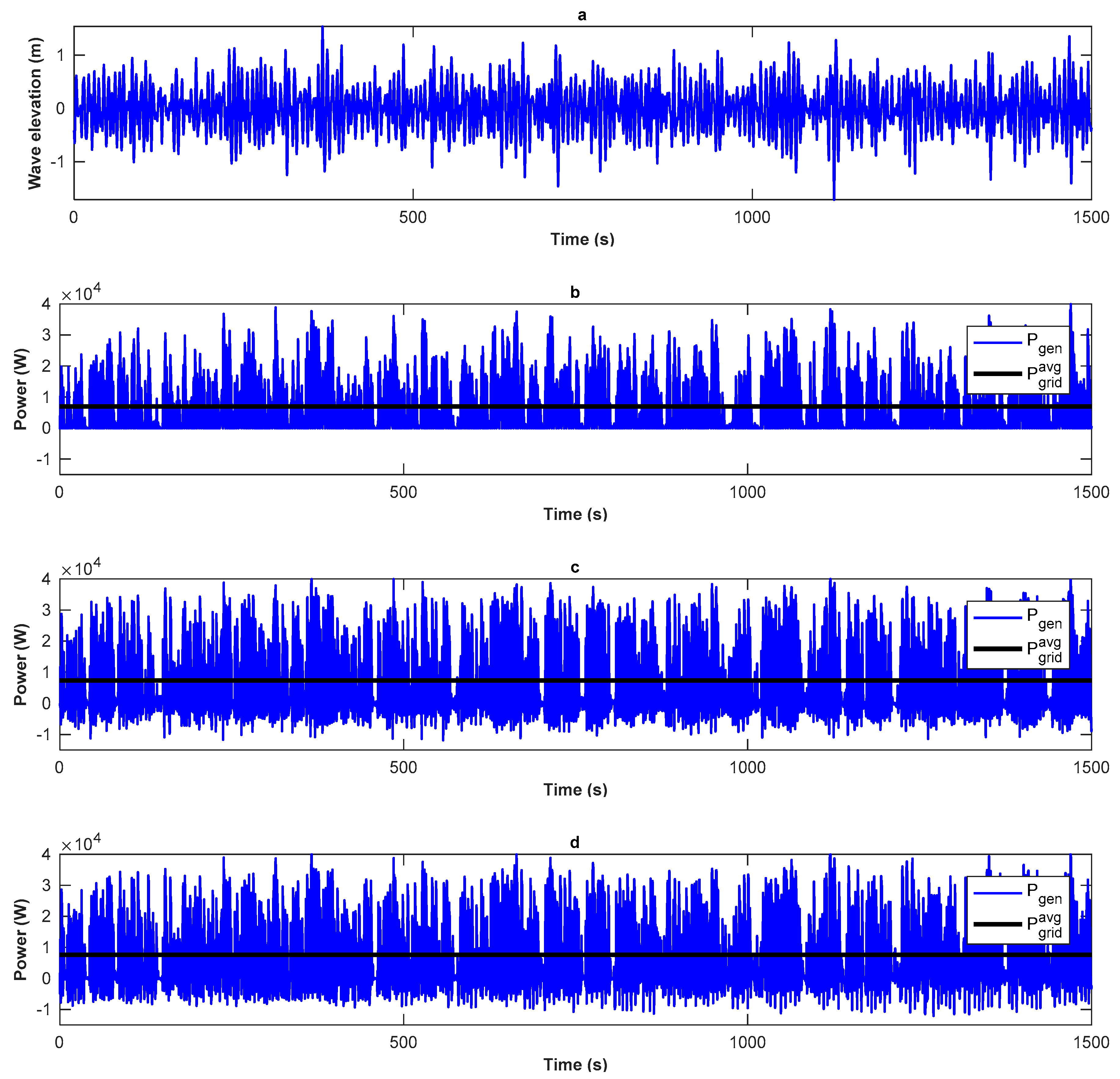1. Introduction
Wave energy has the potential to supply significant amounts of clean and renewable energy to the electrical grid. Adding wave energy into the energy mix of an electrical system can potentially enhance reliability of supply to isolated island communities, while also decreasing transmission losses, as the energy is generated locally. According to [
1], the technically available resource is estimated, in the worst-case scenario, to be 146 TWh/yr, with an installed capacity of 500 GW. The total installed and planned capacity of wave energy converter (WEC) projects is approximately 1 GW, which is well below the worst-case scenario for the technically available resource. One of the main challenges wave energy exploitation faces, according to [
2], is the technology cost, which can vary between 330 € to 630 €/MWh, and is significantly higher compared to the approximately 142 €/MWh for offshore wind. It is, therefore, of crucial importance to reduce the cost of energy. The approach taken in this research paper in order to reduce the cost of wave energy conversion is to increase the production of energy by implementing control methods that aim at maximizing energy at the point that energy is sold. In addition, the increase in power output of a WEC should not affect the cost of production, should include system constraints for rated values, and should be able to be easily applied to devices without the need for significant additional hardware.
At present, several different WEC designs exist, and these can be categorized based on the way they extract energy from the waves, depth of operation, distance to shoreline and power take-off (PTO) type. In this research paper, the focus is given to modelling single-body point absorber WECs with all-electric PTO. Single-body absorbers are chosen because they are more mature, can be designed more easily to suit a specific sea state, and a large number of demonstration projects have been implemented [
3]. The use of an all-electric PTO is crucial for the final goal of this research. By using an all-electric PTO with a direct drive (DD) permanent magnet linear generator (PMLG), the conversion stages between wave energy and electrical energy are minimized, which gives the opportunity for higher conversion efficiencies [
4,
5]. In addition to PMLG, linear switched reluctance generators can also be used, as presented in [
6]. The use of hydraulic PTO systems is quite common in WECs, but they introduce a hydraulic transmission interface between the prime mover and the electrical generator. The hydraulic transmission may operate at constant or variable pressure, using low- and high-pressure accumulators [
7,
8]. Another common approach is to use similar components to those used in the wind and tidal energy industry, such as high-speed electrical generators, permanent magnet synchronous, or induction with a gearbox. The disadvantage of this method, for wave energy, is that an additional component is required, usually a winch, to convert the linear motion of the waves to rotational motion. The winch cylinder can be attached to a gearbox to multiply the speed to appropriate levels for the high speed generator [
9,
10,
11].
Figure 1 summarizes the conversion stages for the different cases above and shows the inherent advantage of using an all-electric approach for the efficiency of the WEC. Even though the DD All-Electric approach is preferred in this research, the control strategies developed for power maximization can be applied to all types of PTOs with some modifications.
Many research papers and groups are focused on maximizing the wave energy captured by the WECs. The majority of previous research has been focused on maximizing the capture of wave energy from the prime mover and its conversion to mechanical energy. This research is summarized in [
12] for several different designs, and an in-depth explanation is given of the process of maximizing the power captured by the prime mover and states the importance of machine learning and model predictive control (MPC) in wave energy. In [
13], the author proposed several causal sub-optimal reactive controllers in order to maximize the power captured from the waves without the need for measuring the frequency of the incoming waves. Similar research presented in [
14] investigated an optimum reactive controller for DD WEC with PMLG when the wave frequencies are measured. The authors in [
15] tried to eliminate the need for advance knowledge of the wave frequency by implementing several frequency estimation methods. Reactive control for maximizing wave energy capture was also the main focus in [
16] for phase control. The authors in [
16] also tested their phase controller in an experimental setup by emulating the WEC through a motor. MPC has been the focus of many researchers for optimizing the hydrodynamic efficiency of the WEC. Their use was recently summarized in [
17]. However, due to the complexity of the MPC controller, uncertainty over its stability and, most importantly, the high computational needs for their improved performance, researchers have also considered simpler approaches with similar characteristics. The controller proposed in [
18] aims at replacing an MPC with filters and transfer functions, which are less computationally intensive to run in real time. The results suggest that the performance of such a controller may be sub-optimal, but with only small differences when compared to an MPC. Another control strategy was presented in [
10], and explored the option of linking the power factor of the generator to the load with the aim of highest possible average power with the least peak power generated. In this paper, the reactive power controllers developed in [
13] will be presented theoretically and designed for a specific test case.
An aspect of crucial importance in WEC modelling and control is the use of constraints. Several constraints can be set, such as peak phase voltage, peak phase current, peak electrical power output from the generator, maximum velocity and displacement of the translator. The authors in [
19] set out some of the electrical requirements in modelling a WEC. They present a novel flux weakening control method for PMGs in order to limit the peak power output to the rated value. The flux weakening method for power limitation, along with constraints set to an MPC for maximum force input, is discussed in [
7]. In this paper, a different approach will be taken to limit the power of the generator by applying a mechanical brake. The power limitation constraint is considered in the optimization process and the use of the mechanical brake is minimized. The maximum velocity can monitored by manipulating the PTO force and the maximum displacement is ensured by having an end-stop which provides an increasing opposing force to the translator of the PMLG [
13,
20]. However, the use of the end-stop for limiting the displacement should only be considered as a back-up, due to the slamming forces that may be applied by the end-stop system to the translator. The controller of the electrical generator should be able to constrain the displacement of the translator, as was presented in [
18].
The aim of this paper is to present a comprehensive method for optimizing a wave-to-wire WEC controller in order to maximize the average power delivered to the connection point. For this purpose, existing controllers were tested and optimized but also a novel velocity-based controller was developed. This differs significantly from maximizing the power capture from the waves. This is due to the fact that, in order to maximize hydrodynamic power, the velocity of the translator must be in phase with the excitation force with an appropriate amplitude. In an irregular sea state, this process may consume significant power to move the translator and therefore limiting the average electrical power produced despite the increased hydrodynamic efficiency. Wave-to-wire optimization can also be realized by observing
Figure 1. The efficiencies of all the conversion stages between the waves and the grid have to be taken into account in order to achieve maximum electrical output at the grid terminals. This is the point at which the modelling of a non-ideal PTO is crucial. The effect of a non-ideal PTO has been studied in several hydraulic-based WEC systems. In [
21], the authors showed that a two-body point absorber WEC can have higher efficiencies compared to a single-body WEC when a non-ideal PTO system is considered. Their approach was based on mathematical modelling and estimated PTO efficiencies for several different PTO damping and stiffness coefficients as well as different body sizes. A similar approach was used in [
22] for single-body WEC but the estimated efficiencies assumed a grid connection. In [
23], the hydraulic-based WEC system was implemented in a laboratory setup and showed that in all cases an optimally designed reactive controller is beneficial even if the PTO efficiency is as low as 60%. The researchers in [
24] thoroughly reviewed wave-to-wire control strategies and stated the importance of having coupled hydrodynamic, mechanical and electrical systems in order to accurately model the operation of WEC systems. The researchers in [
7] and [
25] developed a high-fidelity wave-to-wire WEC system using a hydraulic PTO, and validated the electrical generator and the control structure. In [
26], the MPC is implemented in order to maximize the electrical power output of the generator for a DD system with electrical PTO. The authors defined different stage efficiencies, which helped them perform a cost estimation of the WEC under different cases. Finally, the researchers in [
27] presented a novel hill-climbing control method for maximizing the electrical power output.
To achieve the aim of maximizing the power at the point of grid connection, a detailed wave-to-wire single-body point absorber WEC system was developed using multibody physical modelling. Using multibody physical modelling is a novel aspect compared to the above-mentioned literature, because all of the different conversion stages are considered to be non-ideal, including the hydrodynamics, the PTO and the electrical part with the grid connection. The hydrodynamic, mechanical and electrical modelling process is discussed in
Section 2.
Section 3 presents the controller considered in this research and the subsequent optimization process for power maximization at the grid connection. In addition,
Section 3 presents in detail the velocity-based controller developed specifically for the wave-to-wire power maximization, which was based on the research presented in [
28].
Section 4 presents the implementation of the methodology of
Section 2 and
Section 3 using a realistic test case based on the waters of China. Finally,
Section 5 summarizes the contributions of this research paper.
3. Control Strategies for Wave-to-Wire Power Maximization
The main aim of this research paper is to present ways of maximizing the power delivered to the grid through appropriate generator-side control. As shown in
Section 1, a lot of focus has been given to maximizing the hydrodynamic power captured by a WEC. However, this is not always the optimum solution for power generation, since reactive power is needed when maximizing hydrodynamic power. This means that the generator-side VSC needs to supply the generator with power, driving it as a motor, in order to bring the velocity of the prime mover in phase with the wave excitation force. Another important aspect for an optimum WEC controller is the availability of measurements and, more specifically, the incoming wave frequency measurement. Due to the difficulty of measuring the frequency of the incoming waves, the need for additional hardware and increased cost, this paper focusses on implementation of control strategies that do not require knowledge of the incoming wave frequency. The generator-side controller for WECs with PMLGs can be separated into two parts:
The first part produces an instantaneous reference PTO force (
Fpto*), which forces the point absorber model to move based on the requirements of the control strategy. Depending on the control strategy,
Fpto* can bring, for example, the point absorber velocity into phase with the excitation force from the waves to maximize hydrodynamic power, or can only control the damping to maximize the power transfer without any phase control. As mentioned in
Section 2, the W2W model is based on physical modelling of the mechanical and electrical quantities. This means that the
Fpto* generated by the controller is not directly applied to the point absorber model which is a common practice. The
Fpto* from the control strategy is used as an input to generate pulses for the generator-side VSC. The pulses that control the generator-side VSC will force the PMLG to produce the appropriate PTO force. The block diagram of the generator-side control strategy and the pulse generator are depicted in
Figure 7. The pulse generator for the generator-side VSC is based on the zero d-axis current (ZDC) controller for PMLG.
The ZDC controller requires as inputs
Fpto*,
zpa, the reference
d-axis current (
ids*), and the measured three-phase current at the terminals of the PMLG (
iabc). As shown in
Figure 7b, the displacement is converted to electrical angle, and the
Fpto* is converted to reference
q-axis current (
iqs*). Reference currents,
ids* and
iqs*, are compared to actually measured currents to produce errors. The current errors are fed to PI controllers to generate the appropriate reference voltage signals
Vq* and
Vd* to minimize the current error. The reference voltages are used as input to a PWM scheme for pulse generation for the generator-side VSC.
Regarding
Figure 7a, the point absorber constant properties and instantaneous quantities depend on the specific reference PTO force control strategy and includes the properties given in
Table 1 and instantaneous values of measured displacement, velocity and acceleration of the point absorber. In this section, three different types of reference
Fpto controllers will be presented theoretically and tested for their ability to deliver maximum power to the grid. These control strategies are the real damping, reactive spring-damping and velocity controller. For all three different reference
Fpto controllers the ZDC controller remains the same as a pulse generator for the generator-side VSC.
3.1. Real Damping Controller
The Real Damping Controller (RdC) is one of the most common reaction force control methods. The RdC only provides damping PTO force, which affects the amplitude of the velocity, but not the phase of the velocity. By providing damping PTO force, only real power is produced. The main advantage of this control method is that it is simple and easy to implement. In this research paper, it is implemented based on [
13] by assuming that the PTO impedance only has a real part. The impedance matching ensures maximum power transfer from the waves to the mechanical mass-spring damper system. The reference PTO force generator for the RdC can be described using Equation (7).
where
is the reference PTO force from the RdC method,
is the total damping (radiation and linear) at the wave frequency peak energy in a specific wave climate. Using a variable wave frequency ω
p to calculate the damping and added mass coefficients would lead to improved wave energy capture, but this would require continuous frequency measurements of the incoming waves. Using a single frequency value at which most energy exists for a specific wave climate will allow most of the wave energy for this specific climate to be efficiently converted to mechanical energy, but less energy will be converted overall compared to the use of a variable wave frequency. Simulation results of the W2W WEC system developed using the RdC method are given in
Figure 8.
Figure 8a shows the wave elevation generated by a JONSWAP spectrum with significant wave height (
Hs) 1.45 m and peak energy period (
Te) 6 s. The wave power density for this spectrum in deep water can be calculated using Equation (8) in kW/m.
Using Equation (8), the incoming wave power can be calculated for the buoy under study in this specific sea state.
Figure 8b shows the reference PTO force generated by the RdC method (
) and the actually generated PTO force from the linear generator. It can be observed that the
Fpto closely follows the
, but they are not identical. Some differences appear when the force is above 12 kN. This may be the result of a sudden wave elevation peak.
Figure 8c shows the synchronization of the velocity of the point absorber and wave excitation force. The RdC method does not provide any phase control, and therefore the synchronization is based only on the point absorber’s natural frequency and the incoming wave frequencies. The point absorber’s natural frequency is given in
Table 1 as 1.8083 rad/s, which is larger than the 1.0467 rad/s peak energy frequency of the sea state used. For the calculation of the
using Equation (7),
ωp was equal to 1.0467 rad/s, which is the peak energy frequency of the sea state used.
Figure 8d presents the power output at different stages of the system. The peak instantaneous electrical generator power output (
Pgen) is 19 kW, whereas the average values for the hydrodynamic power (
), generator power (
) and grid power (
) are 1.9147 kW, 1.6909 kW and 1.4701 kW, respectively. This leads to a PMLG efficiency (
) of 88.3% and electrical system efficiency (generator output to grid) of 86.9% (
). If we assume that the power of the incoming waves is
PW, then the hydrodynamic efficiency (
) can also be calculated as being 10.1%. The W2W efficiency (
) is 7.8%. The different efficiencies can be calculated using Equation (9).
Power Maximization Process for the Real Damping Controller
The main idea behind the power maximization process for the RdC is that Equation (7) has several constant parameters that are based on the point absorber constant hydrodynamic properties. Therefore, the constant hydrodynamic properties are also used for the calculation of the reference PTO force and this is to achieve maximum hydrodynamic efficiency .
However, several uncertainties in the constant hydrodynamic parameters may lead to sub-optimal performance. For example, the calculation of the total damping may not be accurate, since it has to contain hydrodynamic damping, which is not calculated as a single value, but rather as a state space model, and the linear damping of the PMLG. Difficulty in calculating these values will certainly lead to reduced performance. Another factor in the power maximization process is that, in order to reduce the cost of energy of WEC devices, it is necessary to maximize the power exported, rather than the hydrodynamic power. It is often assumed that by maximizing hydrodynamic power, the whole system power is maximized, and constant efficiencies for the electrical system are assumed. This is not always the case, as several parameters can affect the electrical power output and electrical efficiencies. For example, a sudden increase in the output current may lead to increased electrical losses due to the rise of temperature in the electrical equipment. Electrical equipment that is sensitive to increases in temperature due to the increased current includes both the power converters and the power transmission cables. Furthermore, as was previously stated in this study, the electrical power constraint is also included to avoid power output that can damage the electrical equipment. Finally, the location each WEC is installed has a specific wave energy climate. This wave energy climate can be measured and quantified so that the WEC installed at this specific wave climate may perform adequately. To summarize, the power maximization process is needed because:
The constant hydrodynamic parameters in the calculation of the reference PTO force may not be accurate.
The objective is to increase the power exported to the grid and not necessarily the power captured by the waves. The behavior of the electrical generator can change the losses in the electrical system.
The mechanical and electrical constrains have to be included in the generation of the reference PTO force.
Each WEC is installed for a specific wave climate. The reference PTO force has to be modified to reflect power maximization for this specific wave climate.
To perform power maximization, Equation (7) is re-written in Equation (10). Two constant hydrodynamic parameters are identified as the ones that are difficult to calculate and affect the calculation of the significantly, the damping and the stiffness.
In Equation (10), the damping
and stiffness
are considered unknowns, and are modified in order to maximize power exported to the grid. Using the constant hydrodynamic parameters as initial guesses, several optimization algorithms can be implemented in order to maximize
. The optimization algorithms used in this study were implemented in MATLAB and are based on grid search and constrained non-linear algorithms such as sequential quadratic programming. The theory and formulation of these algorithms is outside the scope of this paper.
Figure 9 presents the results of the grid search optimization process, which focuses on changing the
and
with the aim of maximizing power at different points of the W2W WEC system.
It can be observed that
affects the output of the WEC system, whereas the effect of
is quite small for the range of values used in the grid search optimization. The maximum power for all cases appears to be around 14,000 N/m, with the damping having minimum impact at this scale. Apart from the grid search optimization algorithm, which is time consuming and is based on fixed steps for the design variables, a gradient descent active-set algorithm was used to calculate the
and
for maximum power at the grid. The summary of results for all the algorithms and the reference case are presented in
Table 5. It should be noted that the optimization is based on a 150 s simulation using the wave energy resource presented in
Figure 8a. Based on the results presented for optimizing the Real Damping Controller, higher W2W efficiencies can be achieved with minimal impact on the peak-to-average ratio of the generator power (
). It should be noted that, due to the fact that the WEC system presented has a power limitation mechanism, this is included in the optimization process to achieve maximum power at the point of grid connection.
3.2. Reactive Spring Damping Controller
The Reactive Spring Damping Controller (RsdC) is a sub-optimal complex conjugate controller that uses the constant peak energy frequency ωp of the sea state and does not include an inertia term in the calculation of the reference PTO force . The reference PTO force calculation for the RsdC is described in Equation (11).
Simulation results of the W2W WEC system developed using the RsdC method are given in
Figure 10.
The wave energy resource shown in
Figure 10a is the same as the one for the Real Damping Controller. In
Figure 10b,
is compared with the actual
Fpto generated by the PMLG. The PMLG PTO force does not follow the reference signal in all the cases. Several factors can affect this performance including PMLG design parameters such as the phase inductance. An additional observation is that
Fpto has much higher values compared to
Figure 8b. Regarding phase synchronization between the wave excitation force and the velocity of the point absorber, it is evident that the RsdC affects the
phase, especially when compared to
Figure 8c. Apart from the phase control, the amplitude control of the RsdC is significant as well. The velocity of the point absorber reaches 0.6 m/s even at low excitation force amplitudes. Finally, the power at different stages can be seen in
Figure 10d. The peak instantaneous electrical generator power output (
Pgen) is 23.8 kW, whereas the average values for the hydrodynamic power (
), generator power (
) and grid power (
) are 2.6549 kW, 2.2537 kW and 2.0247 kW, respectively. This leads to
= 84.9%,
= 89.8%,
= 14.1% and
= 10.7%. The different efficiencies are calculated using Equation (9). In addition, reactive power flow can be seen in
Figure 10d. The peak negative power at the generator terminals is around 2 kW, and the average negative power in a 150 s simulation is 680 W. By implementing the RsdC, total power to the grid is increased by 38% compared to RdC, despite the negative power consumed by the generator to perform phase control. In the following section, the RsdC is optimized in a similar way to the RdC in order to maximize the power exported to the grid.
Power Maximization Process for the Reactive Spring Damping Controller
The main idea behind the power maximization process for the RsdC is that Equation (11) has several constant parameters that are based on the point absorber constant hydrodynamic properties. Therefore, the constant hydrodynamic properties are also used for the calculation of the reference PTO force, and this is done in order to achieve maximum hydrodynamic efficiency, . The WEC controllers are optimized in order to maximize . An additional characteristic of the RsdC compared to the RdC is that it has reactive power, allowing it to carry out phase control of the point absorber. Reactive power control leads to power being consumed by the PMLG in order to bring the velocity of the point absorber into phase with the wave excitation force. The amount of power consumed can significantly affect the total power generated. The reasoning behind performing optimization in the RsdC is similar to the RdC, and is reproduced here with the addition of the control of the reactive power to achieve the desired target:
The constant hydrodynamic parameters in the calculation of the reference PTO force may not be accurate.
The objective is to increase the power exported to the grid, and not necessarily the power captured by the waves. The behavior of the electrical generator can change the losses in the electrical system.
The mechanical and electrical constraints have to be included in the generation of the reference PTO force.
Each WEC is installed in a specific wave climate. The reference PTO force has to be modified to reflect power maximization for this specific wave climate.
Reactive power control can bring the point absorber into phase with the wave excitation force for maximum power extraction from the waves, but may lead to excessive power being consumed by the WEC. The amount of reactive power has to be controlled through optimization.
To perform power maximization, Equation (11) is rewritten into Equation (12). Two constant hydrodynamic parameters are identified as being difficult to calculate and as significantly affecting the calculation of : damping and stiffness.
In Equation (12), damping
and stiffness
are considered unknowns and are modified in order to maximize power exported to the grid. Using the constant hydrodynamic parameters as initial guesses, several optimization algorithms can be implemented in order to maximize
. The optimization algorithms used in this study were implemented in MATLAB and are based on grid search and constrained non-linear algorithms such as the sequential quadratic programming.
Figure 11 presents the results of the grid search optimization process which focuses on changing the
and
with the aim of maximizing power at different points of the W2W WEC system.
Figure 11 depicts power output of the point absorber (
Figure 11a), generator (
Figure 11b) and grid (
Figure 11c) for different parameters of
and
. For each case, the
and
that gives the maximum average power is identified, cross (+) for maximum
, cross mark (x) for maximum
, and asterisk (*) for maximum
. In
Figure 11d, the maximum power points are overlapped on the contour plot of power exported to the grid. It is shown that maximum power is achieved at different combinations of
and
, which shows how much reactive power can affect the power output at different stages of the system. The maximum
and
are at the same
and
values, which indicates that optimizing generator power output may suffice for W2W optimization, but this is a single case and cannot be generalized.
Apart from the grid search algorithm visualized in
Figure 11, a gradient descent algorithm was also used in a similar way as in the RdC. The results for a 150 s simulation are presented in
Table 6. Based on the results presented, optimizing the Reactive Spring Damping Controller, higher W2W efficiencies can be achieved with small impact on the
.
In
Table 6, it is shown that, when using the Grid Search Method for maximizing
, a maximum of 3.088 kW is absorbed by the point absorber. However, the average grid power in this case is 2.235 kW, which is lower than the Grid Search Method for maximizing
. Therefore, it can be concluded that maximizing the mechanical power captured by the point absorber does not necessarily lead to the maximum power at the grid side. The Gradient Descent Method identifies more detailed values for
and
in order to achieve
maximization, but the difference is negligible compared to Grid Search. The only significant advantage of the Gradient Descent in this case is the reduced simulation time of the algorithm to find these specific values.
3.3. Velocity Controller
The velocity controller (VelC) was first introduced in [
28] for an array of DD WEC with energy storage at the DC link. The main idea behind the velocity controller is based on the equations given in (13).
The first equation in (13) relates to the optimum velocity,
, the amplitude of the point absorber with the real part of the intrinsic impedance of the system,
, and the phase of the optimum velocity with the wave excitation force
. Both the wave excitation force and the real part of the intrinsic impedance of the system are changing depending on the frequency of the incoming waves. The second equation in (13) shows that, in order to achieve maximum
, the
and
need to be in phase. The block diagram of the components comprising the velocity controller for DD WEC is shown in
Figure 12.
As is shown in
Figure 12, the velocity controller is composed of three parts: Velocity Phase Control, Velocity Amplitude Control and the Speed Control. Velocity Phase Control uses the hydrodynamic parameters of mass, added mass and stiffness as well as the real time measurements of the point absorber acceleration (
) and displacement in order to estimate
(
). The estimator uses Equation (14) to calculate
.
The is normalized by dividing it by the rated mechanical force to construct the phase component of . The damping component in the calculation of is not considered due to its minimal effect on the phase component. In addition, it is desirable to reduce the dependency of from the constant hydrodynamic parameters, which may change during the lifetime of the WEC. For this purpose, the use of Kalman filters may be considered for predicting the phase component of . The Velocity Amplitude Control of the velocity controller is mainly composed of a Look-up table, which generates the optimum velocity () amplitude as a function of the phase component of (). The amplitude and phase are multiplied to create the optimum velocity of the point absorber . The and the actually measured velocity are compared, and the velocity error is used as input to a PI controller. The output of the controller is the reference PTO force of the velocity controller, which aims to minimize the error between the optimum and the actually measured velocity.
Two sets of parameters are not predetermined in the velocity controller, the Look-up table and the tuning of the Speed Controller. The Look-up table can be defined in two different ways: the first assumes a linear relationship between the optimum velocity amplitude and the optimum phase. The linear relationship is based on the peak velocity the point absorber can have, and for simplification, the Look-up table can be replaced with a gain block with the peak velocity of the point absorber as a parameter. The second method assumes that the optimum velocity amplitude needs to be constant regardless of phase. The Look-up tables created based on these two different assumptions are shown in
Figure 13.
The v
linear approach uses the maximum velocity of the point absorber (1 m/s) for all the normalized excitation force input points. Therefore, at rated excitation force, the optimum velocity will be the maximum, and a linear approach is used for the rest of excitation force input points. The v
constant approach for the Look-up table aims at keeping the velocity of the point absorber near the maximum velocity, despite the low excitation force input. Therefore, at low
, the velocity magnitude is high, and at high
, the velocity magnitude tends to 1 m/s. The W2W WEC with the v
linear VelC is simulated under the same resource as the previous controllers, and the results are presented in
Figure 14.
In
Figure 14, it can be observed that a good match is achieved between the reference and actual PTO force. This helps to produce a synchronized instantaneous velocity with the
, which is an estimate of the input wave excitation force. In
Figure 14c, this synchronization can be seen, and it can be observed that the instantaneous velocity of the point absorber follows the phase of the actual
effectively.
Figure 14d presents the power output at different stages of the W2W WEC. The peak instantaneous power of the PMLG is 20.5 kW, whereas the average values for the hydrodynamic power (
), generator power (
) and grid power (
) are 2.5711 kW, 2.1479 kW and 1.9134 kW respectively. This leads to a
= 83.5%,
= 89.1%,
= 13.6% and
= 10.2%. Finally, it is also shown that the VelC works in a similar way as a reactive controller which performs both phase and amplitude control. For that purpose, the PMLG absorbs power at some instances and in the 150 s simulation presented in
Figure 14 the average negative power was 557 W. A summary of the results for the v
linear VelC and v
constant VelC, along with all the options presented in this paper, is given in
Section 3.4.
Power Maximization Process for the Velocity Controller
The main idea behind the power maximization process for the velocity controller is that the Look-up table can significantly affect the efficiency of the controller. In
Section 3.3, by using a simple linear relationship between
and
, the phase between
and
was efficiently synchronized, but the amplitude of the velocity was not optimized. The gradient descent algorithm can be used to optimize the Look-up table of the VelC so that the W2W WEC system achieves maximum
. As was stated in the optimization process of the RdC and RsdC, the following aspects are taken into account for the optimization of the VelC:
The objective is to increase the power exported to the grid, and not necessarily the power captured by the waves. The behavior of the electrical generator can change the losses in the electrical system.
The mechanical and electrical constrains have to be included in the generation of the reference PTO force.
Each WEC is installed in a specific wave climate. The Look-up table has to be modified to maximize power for the specific wave climate.
Reactive power can bring the point absorber into phase with the wave excitation force for maximum power extraction from the waves, but may lead to excessive power consumption by the WEC. The amount of reactive power has to be controlled through optimization.
The optimized Look-up table for the 150 s wave resource shown in
Figure 14a is given in
Figure 15.
The results from the simulation of the different velocity controllers are presented in
Table 7. Based on the results presented, the VelC achieves high W2W efficiencies in all cases with smaller
compared to RdC and RsdC keeping the control method cost efficient.
3.4. Summary of Controller Options
Table 8 summarizes the results obtained with the different controllers and compares the W2W efficiency between each controller and the RdC Reference. It is observed that the VelC v
grid has the highest W2W efficiency with an average of 2.498 kW for a 150 s simulation. The VelC v
grid achieved more than 5% extra efficiency, and an additional 1 kW power at the grid compared to the RdC Reference. High efficiencies were also achieved when the VelC v
constant, RsdC Gradient Descent and RsdC Grid Search were used.
